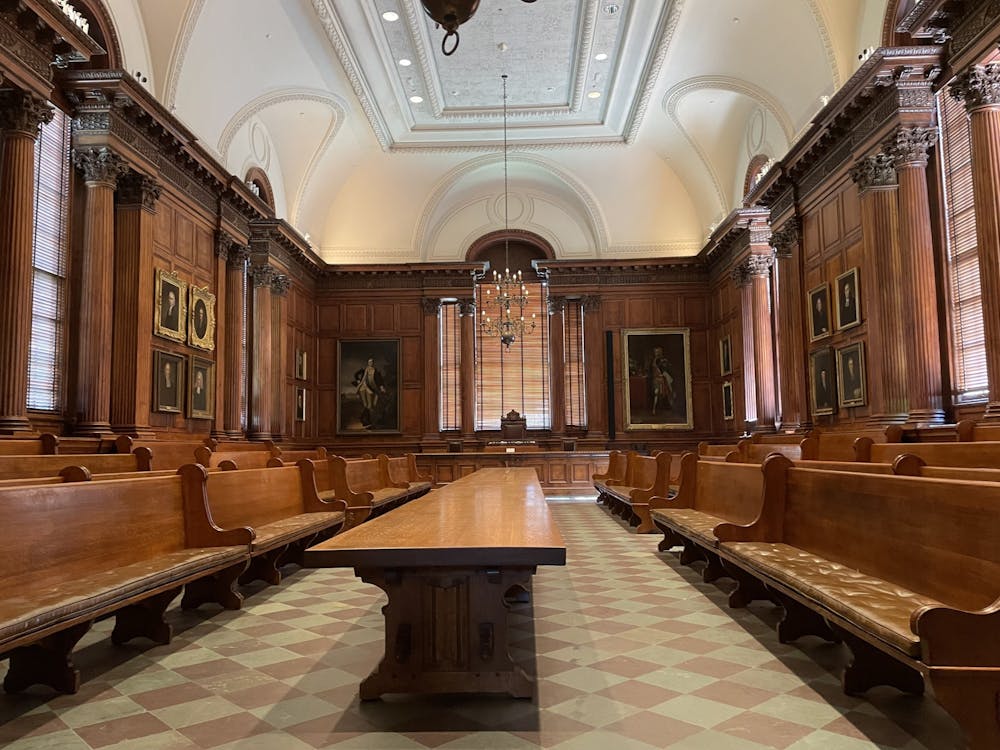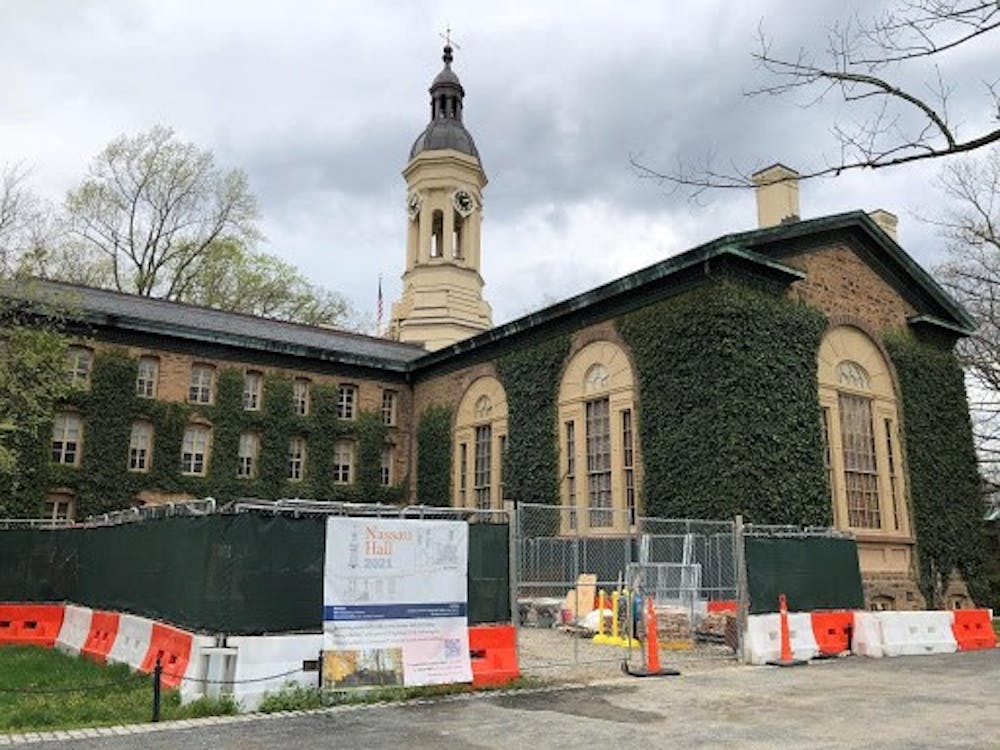On Aug. 26, Naomi Hess ’22 became the first person in Nassau Hall's 265-year history to enter and tour the building in a wheelchair without assistance. The installation of an elevator in Nassau Hall was completed six days prior as part of a series of construction projects intended to make campus more accessible to individuals with disabilities.
Upon special invitation from the Vice President for Facilities, KyuJung Whang, Hess entered through a new south-west entrance, ascended the newly installed elevator, and was shown around the building. In the past, ramps erected for special events only provided limited wheelchair access.
“We went to every floor, and I was just really awestruck to enter this building that is so important to this campus,” said Hess in an interview with The Daily Princetonian.
Hess is an associate news editor for the ‘Prince’.
The historic Nassau Hall, built in 1756, was once “the largest stone building in the American Colonies” and briefly served as the nation’s capital in 1783. It currently houses, among many meeting rooms and offices, the President’s office and the Faculty Room, where the Board of Trustees meets.
This summer, workers installed an elevator and a new ground-level entrance to make Nassau Hall accessible. The team also added accessible door handles throughout the building as well as new energy-efficient lights, according to the announcement from the University.
The work was realized through a combination of long-term University efforts and student advocacy by Hess and others. Hess, who has a rare form of muscular dystrophy and navigates campus on an electric wheelchair, is a fellow in the AccessAbility Center and a co-chair of a student government task force on accessibility.
“The University has long wanted to make Nassau Hall more accessible to allow everyone the ability to experience a vital part of our state’s and our nation’s history,” wrote Alexis Mutschler, the Assistant Director of Special Projects in Facilities Operations, in a statement to the ‘Prince’.

“Over the past 15 years, the University explored options for adding an elevator while maintaining the historic aesthetic and layout both inside and out, but none of those options was quite right,” she continued.
In 2017, the University hired the local architectural firm Mills + Schnoering to determine if an elevator would fit in the building and where it could be placed. The firm, led by Michael Mills ’73, decided to place the elevator in the southwest side to provide easy access to the previously installed accessible restrooms and to “have the least impact to the layout of the building,” according to Mutschler.
In the fall of 2019, shortly after these plans were finalized, Hess was taking a journalism class, JRN 445: Accountability Reporting, with Joe Stephens. One of the class’s guest speakers was Paul Haaga ’70, former CEO of NPR and Chair of the Grounds and Buildings Committee of the Board of Trustees.
“[Haaga] asked us if we had anything we’d like to say to a trustee, and I brought up accessibility,” said Hess.

“He emailed me the week after we met to say that KyuJung Whang [the VP of facilities] wanted to take me to lunch, and also invited me to speak at a trustee meeting.”
Hess met Whang for lunch in Prospect House, and they spoke about how to improve accessibility on campus. Hess mentioned Nassau Hall.
“I promised her that day that she would be able to enter Nassau Hall and see the Memorial Room and the Faculty Room before she graduated,” wrote Whang in an email to the ‘Prince’. “I am so pleased to be able to keep my promise.”
Hess was able to visit Nassau Hall’s many rooms, including the famous Memorial Room, where the names of all Princetonians who died in wars are engraved on the walls, and the Faculty Room, where the Board of Trustees meets.

Faculty Room in Nassau Hall
Naomi Hess / The Daily Princetonian
“While I was in the [Faculty] Room, President Eisgruber walked by and he looked like he was in a rush but he popped in to see how I was doing,” Hess said.
“I was just really, really happy to see this accessibility upgrade as a symbol of improving access and inclusion even on this very old campus,” she added.
However, Hess also believes that such renovations were long overdue, and more work to improve accessibility is needed.
“In my opinion, the fact that it wasn’t accessible until recently was really disheartening because people with disabilities cannot access the most important people on this campus,” said Hess.
Other students with disabilities agree with Hess.
“I know there’s something about the aesthetics of there being steps to the main entrance that makes it feel like you're not able to go in [Nassau Hall],” said Ellen Li ’22 in an interview with the ‘Prince’.
Li navigates campus on a scooter or wheelchair, and is one of the founding members and the Treasurer of the Disability Collective. She is also an associate features editor for the ‘Prince’.
In order to improve accessibility, the facilities team works with both students and the Office of Disability Services.
“Feedback is a vital component of the open dialogue we want to have with the campus community. Our job is to maintain the campus to allow the students to thrive,” Mutschler wrote. “We enjoy hearing what we’re doing well, but we also want to remove obstacles that make it harder for our community members to access our spaces, learn, and socialize.”
According to Mutschler, examples of recent renovations increasing accessibility include new accessible paths around campus, modifying chair/vertical lifts on campus to be keyless, an accessible ramp to the stage in McCosh 50 as well as motorized writing tables for the accessible seat locations, and more accessible restrooms in the E-Quad.
In addition, an elevator and a more prominent and accessible entrance will be added to Dillon Gym, and “the new Hobson College expansion will remove some of our inaccessible dormitories in First College, and create a more accessible college layout,” wrote Mutschler.
Still, Li noted that even when roads are technically accessible, they can still be rocky, and that “especially with construction going on I would like there to be a little bit more mindfulness about what it’s like to navigate campus on a wheelchair.”
“There are so many buildings both on campus and in town that are not fully accessible, which has definitely proven to be a challenge for me, and Princeton has so much money that I wish they would dedicate more towards these sorts of construction improvements, because if they can make Nassau Hall, which was built in the 1750s, accessible, then they have the resources to do much more,” Hess said.
“This is just a step forward in terms of accessibility, but I hope that it’s not the end of the movement and the awareness of the importance of these sorts of renovations,” she continued.
Miguel Gracia-Zhang is a staff writer who often covers University affairs and local news. He can be reached at mg43@princeton.edu or on Twitter at @gracia_zhang.








